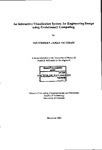An Interactive Visualisation System for Engineering Design using Evolutionary Computing
| dc.contributor.author | PACKHAM, IAN STEPHEN JAMES | |
| dc.contributor.other | Faculty of Science and Engineering | en_US |
| dc.date.accessioned | 2013-09-19T11:54:00Z | |
| dc.date.available | 2013-09-19T11:54:00Z | |
| dc.date.issued | 2003 | |
| dc.identifier | NOT AVAILABLE | en_US |
| dc.identifier.uri | http://hdl.handle.net/10026.1/1876 | |
| dc.description.abstract |
This thesis describes a system designed to promote collaboration between the human and computer during engineering design tasks. Evolutionary algorithms (in particular the genetic algorithm) can find good solutions to engineering design problems in a small number of iterations, but a review of the interactive evolutionary computing literature reveals that users would benefit from understanding the design space and having the freedom to direct the search. The main objective of this research is to fulfil a dual requirement: the computer should generate data and analyse the design space to identify high performing regions in terms of the quality and robustness of solutions, while at the same time the user should be allowed to interact with the data and use their experience and the information provided to guide the search inside and outside regions already found. To achieve these goals a flexible user interface was developed that links and clarifies the research fields of evolutionary computing, interactive engineering design and multivariate visualisation. A number of accessible visualisation techniques were incorporated into the system. An innovative algorithm based on univariate kernel density estimation is introduced that quickly identifies the relevant clusters in the data from the point of view of the original design variables or a natural coordinate system such as the principal or independent components. The robustness of solutions inside a region can be investigated by novel use of 'negative' genetic algorithm search to find the worst case scenario. New high performance regions can be discovered in further runs of the evolutionary algorithm; penalty functions are used to avoid previously found regions. The clustering procedure was also successfully applied to multiobjective problems and used to force the genetic algorithm to find desired solutions in the trade-off between objectives. The system was evaluated by a small number of users who were asked to solve simulated engineering design scenarios by finding and comparing robust regions in artificial test functions. Empirical comparison with benchmark algorithms was inconclusive but it was shown that even a devoted hybrid algorithm needs help to solve a design task. A critical analysis of the feedback and results suggested modifications to the clustering algorithm and a more practical way to evaluate the robustness of solutions. The system was also shown to experienced engineers working on their real world problems, new solutions were found in pertinent regions of objective space; links to the artefact aided comparison of results. It was confirmed that in practice a lot of design knowledge is encoded into design problems but experienced engineers use subjective knowledge of the problem to make decisions and evaluate the robustness of solutions. So the full potential of the system was seen in its ability to support decision making by supplying a diverse range of alternative design options, thereby enabling knowledge discovery in a wide-ranging number of applications. | en_US |
| dc.language.iso | en | en_US |
| dc.publisher | University of Plymouth | en_US |
| dc.title | An Interactive Visualisation System for Engineering Design using Evolutionary Computing | en_US |
| dc.type | Thesis | |
| plymouth.version | Full version | en_US |
| dc.identifier.doi | http://dx.doi.org/10.24382/4612 |
Files in this item
This item appears in the following Collection(s)
-
01 Research Theses Main Collection
Research Theses Main


